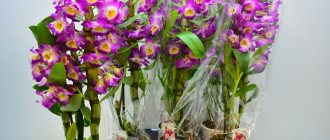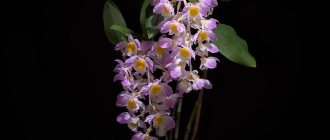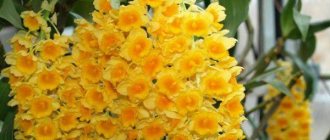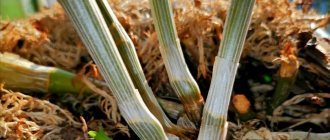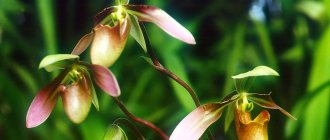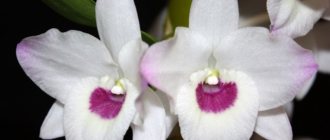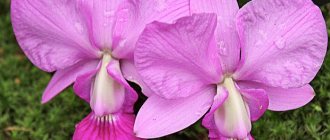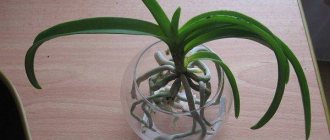One of the most beautiful types of Dendrobium orchids and, moreover, the most common in indoor floriculture is Dendrobium Nobile. The advantages of this orchid are its spectacular appearance, luxurious flowering, amazing aroma, so pleasant, slightly sweet and not at all cloying! Even novice gardeners can grow Dendrobium Nobile, because knowledgeable people compare this flower to geranium due to its unpretentiousness. In this article we will introduce you to this epiphytic beauty and tell you about the proper care of Dendrobium Nobile at home.
Description of the plant
A peculiarity of Dendrobium Nobile is the location of its peduncles - along the entire length of the pseudobulb
This type of orchid is most often found high in the mountains of India, Thailand, Nepal, Vietnam, and the Himalayas. Back in 1836, she was brought from India to Europe, where she amazed everyone with her unusual beauty. Translated from Greek, the name of the orchid “Dendrobium” sounds like “living on a tree”, and the prefix “Nobile” means “noble, excellent, noticeable or famous”. The second name of this orchid, Dendrobium Noble, very accurately characterizes this plant. A tall bush, about 60 cm, has an original, very impressive appearance. Purple with a yellow spot, pink, white or red flowers cover the trunk so thickly that the bush looks like a living bouquet. Its fleshy, straight stems (pseudobulbs) with a characteristic glossy tint are usually cylindrical, thickened in the lower part, and decorated with wide leaves in the upper part. Peduncles with large bright fragrant flowers appear on them in the second year of life.
The flowers of Dendrobium Nobile are united in inflorescences, which, depending on the age of the orchid and the variety of the hybrid, can have from 1 to 3 flowers. And the entire pseudobulb, if you count it, can be decorated with from 50 to 70 flowers. The diameter of one flower can reach 10 cm, but on average it is from 5 to 8 cm. Natural species of Dendrobium nobilis have white petals with purple tips and a cream-colored lip with a pinkish edging and a dark purple throat. And hybrid varieties come with white, orange, purple, lilac, dark purple flowers, even variegated ones. The shape of the petals is ovoid with elongated sepals. Flowering occurs in February - March. The shoots of an adult flowering Dendrobium are literally strewn from base to top with large, unusually beautiful flowers. Each flower stays on the peduncle for up to two months.
Hybrid varieties of Dendrobium Nobile can bloom twice a year. Or they may miss a year in flowering. But then, usually the next year, the orchid lays a much larger number of flower buds, since the shoots of the missed year also begin to bloom.
The Dendrobium Nobile orchid belongs to the sempoidal type, i.e. new rosettes of leaves (growths) appear on rhizomes (rhizomes) at the base of old ones. Each such sprout (shoot, pseudobulb) lives from two to four years. When young it is slender, and as it ages it bends over and can take on a lodging shape. Over time, the pseudobulb grows longer than a meter, becomes bare and, having formed daughter rosettes, dies. In the axils of alternately growing leaves, flower buds or new shoots are formed, which can subsequently be used for propagation by cuttings.
The shape of the Dendrobium Nobile orchid flowers, their color and aroma do not leave any gardener indifferent. Even experts in this culture admit that this orchid is the most suitable for growing at home.
Varieties
The most famous line of hybrids based on Nobile is named after the Japanese breeder - Yamamoto hybrids.
Let's look at the most popular Greeks.
Yellow Song (D. nobile Yelow Song Canary)
The height of the bush is 40 cm, the flowers are single-colored, bright yellow, 6 cm in diameter. The lip is rounded, funnel-shaped, with wavy edges and an orange spot. The aroma is fruity and floral .
Fancy Angel (D. nobile Fancy Angel Lycee)
With a delicate lemon aroma. The stems are 30 cm high. The flowers are velvety, about 6 cm in size. The color of the petals is white and lilac. The lip is white, with a lilac edging and a yellow spot in the center.
Spring Dream (D. nobile Spring Dream Apollon)
Plant height 45 cm. The flowers are white, diameter 5-6 cm, with a large yellow spot on the lip. Petals with wavy edges. The aroma is fresh, fruity and herbaceous .
Important to know when purchasing
Usually, a flower newly purchased in a store looks great, blooms well and does not require special care for some time. The owner of Dendrobium considers himself the happy owner of an ideal, completely unpretentious flower. We will disappoint you - without proper care, the plant most likely will not bloom again and may die. The thing is that when growing and preparing orchids for sale, greenhouses use strong drugs - growth stimulants and long-acting fertilizers. They provide plants for sale with a supply of vitality and nutrients only for a few months. The sooner the plant gets into conditions that are comfortable for its existence, the sooner the owner begins to competently take care of his pet, the longer Dendrobium Nobile will be able to delight others with its presence and flowering.
When is a transplant needed?
If the plant is healthy and doing well, there is often no need to replant it in a new pot. Main reasons for transplantation:
- Sick and enlarged measles system.
- The false bulbs have greatly increased in size.
- The pot is too small.
- The roots have grown and no longer fit in the pot.
- The soil mixture smells acidic.
Home care
In nature, Dendrobiums are plants with a pronounced seasonality. Their development cycle includes periods of active growth, flowering and dormancy. And for each such time period you will have to create your own conditions in your home.
The Dendrobium Nobile orchid constantly develops throughout the year. Four conventional periods of her life can be distinguished:
- Vegetation . At this time, new shoots appear at the base of old pseudobulbs (babies).
- Formation of new pseudobulbs . The young sprout develops and catches up in size with the old pseudobulb, i.e. itself becomes a pseudobulb.
- The period of laying peduncles . At this time, the plant is in a dormant period.
- Bloom . At this time, flowers bloom on the peduncles. Different hybrid varieties have different durations of this period.
Let's consider the basic rules for caring for the Dendrobium Nobile orchid at different periods of its life.
Lighting and flower location
It is known that the light-loving orchid does not tolerate direct sunlight well, although without bright, but diffuse sunlight for 12 hours a day, it is even worse. Therefore, when choosing a place for a pot, pay attention to the windowsills in the eastern or western direction. It is also possible to grow in the south, provided that the plant is protected from the rays of the midday sun scorching through the glass using light blinds or curtains. When growing a flower near northern windows, you will need to use artificial sources of daylight so that the orchid does not suffer from lack of light. Outdoors during the summer months it thrives in both light shade and sun. The brighter and longer the lighting, the more abundant and colorful it will bloom. Pay attention to the leaves. If they are too dark, there is not enough light. If the leaves of a plant are too light on a sunny windowsill, they will burn through the glass and may get sunburned. The Dendrobium Nobile orchid should have lush green leaves.
Temperature
Optimum room temperature during the day: in summer 22 – 28 degrees. and 15 – 20 gr. in winter. This orchid easily tolerates fairly high temperatures, up to 32 degrees, with comfortable ambient humidity. To stimulate flowering, the plant needs a difference between day and night temperatures within 5 - 10 degrees. Temperatures below 15 degrees are considered critical for summer. at night and above 33 degrees. during the day.
During flowering, it is advisable to reduce the temperature and maintain about 18 degrees. – then the flowering itself will last longer.
If Dendrobium Nobile is kept outdoors (in the garden, on the veranda), the difference in daily temperatures will occur naturally. If the flower is kept indoors all year round, at night, to reduce the temperature, you need to ventilate the room well, if necessary, turn off or block the heating devices, do wet cleaning and spraying.
This may be interesting: General rules for caring for Dendrobium orchids
With the onset of autumn, the temperature of the flower should be reduced to 20 - 22 degrees. in the afternoon and about 16 degrees. at night.
Watering Dendrobium Nobile
Sometimes the room is dry and hot, and sometimes it’s cool and damp. Focus on the microclimate in which your flower has to live. Dendrobium Nobile is watered as often as its substrate requires. If it dries out, it needs another watering. In summer this happens two to three times a week, in spring and autumn - once every 10 to 15 days. During the dormant period, the flower may stop consuming moisture altogether and is practically not watered until new flower shoots appear.
Water for irrigation is used that is soft, clean, warm, filtered or settled for 24 hours and heated a couple of degrees above room temperature. You can use boiled water after it has cooled to a temperature a couple of degrees higher than the air in the room.
Watering is carried out in different ways. It is best to place the flower pot in a bowl of filtered warm water so that only the lower part of the pot is in the water. Within a few minutes, the substrate will be thoroughly saturated with moisture, and the pot can be removed and placed in a tray to drain excess liquid. We recommend combining such watering with fertilizing by adding liquid fertilizers for orchids to the water.
You can simply add water to the pan during the next watering until it stops being absorbed into the substrate. Then after 20 - 30 minutes, excess moisture must be drained from the pan.
At the end of the growing season, while preparing the Dendrobium for flowering, reduce watering by half and stop feeding. At this time, we recommend periodically giving the orchid a bath in a hot shower with a water temperature of 35–40 degrees. After an evening bath, blot water in the axils of the leaves to prevent the trunk from rotting.
Such bathing will not only clean the leaves of the plant, but also improve gas exchange in its tissues and stimulate future flowering. When flower buds appear, watering and feeding should be resumed.
Humidity
Dendrobium Nobile orchids grow best in normal and high ambient humidity. The minimum permissible humidity limits are 40% - 50%. Hot, dry weather slows down the growth of an orchid, and sometimes stops it altogether. It is better if the humidity is higher. To increase it, wet stones, moss, and large pieces of pine bark are placed in the tray. Do not place the pot in water, so as not to cause rotting of the roots. To retain moisture in the pot, cover the surface of the substrate with moss. Frequent spraying with a fine spray bottle is used both on the bush and in the surrounding air. This is especially true for hot summer days and with the onset of the heating season.
Soil for Dendrobium Nobile
To plant and replant Dendrobium Nobile, use purchased soil for orchids or epiphytic plants. It’s also not difficult to prepare the substrate yourself if you live near a pine forest. The basis of the soil for orchids are pieces of old pine bark measuring from 1 to 3 cm, which must first be thoroughly dried and then boiled in water a couple of times to ensure that it is cleaned of any fungi and viruses. It is also necessary to add pieces of charcoal to the substrate to prevent soil acidification and root diseases. You can add fern roots if you have them, bottle caps, coconut fiber. If your flower is on a south-facing window, you should add pieces of sphagnum moss to the substrate - it will retain moisture.
If the pot is placed on a north-facing window, then small pieces of polystyrene foam should be added to the substrate to loosen it further. The presence of a small amount of peat in it has a positive effect on the quality of the soil. This is a slightly strange substrate that orchids love. It does not serve to obtain nutrients, but rather to secure the Dendrobium roots in the pot and provide better ventilation. We recommend pouring boiling water over the substrate you prepared yourself, letting it sit for about 15 minutes, then draining the water and waiting for the soil to dry. Now the soil is ready for use.
Transplanting Dendrobium Nobile and choosing a pot
Dendrobium Nobile does not need frequent replanting into a new pot and new substrate. He does not tolerate changes in environment and conditions of detention. Even after purchasing an orchid, it is transplanted into a new pot next spring, not earlier. A healthy plant will need the next transplant in three to four years. In addition, Dendrobium Nobile feels better in a cramped pot when the gap between the roots and the walls of the pot does not exceed 2 cm.
Transplantation is only necessary in a few cases. And then they try to carry it out only after flowering has ended:
- The substrate turned to dust. The roots have nothing to grab onto and do a poor job of holding the flower in the pot.
- The root system filled the entire space in the pot and displaced all the substrate from it. The roots are sticking out. The pot became clearly too small.
- If you notice a brown coating, rot, or the soil has become salty on the rhizome, then do not wait for trouble and, without waiting for the end of flowering, transplant the flower into a new substrate, having previously cut off the damaged and diseased parts of the root.
So, for replanting, prepare a pot of the required size.
It should be quite high so that, in addition to the plant, it can accommodate a layer of drainage of at least three to four cm made of heavy, large, but sterilely clean stones. This is necessary so that the orchid, having a relatively weak root system and heavy, fleshy leaves, cannot overturn the pot.
The pot does not have to be transparent, since the root system of Dendrobium Nobile, unlike Phalaenopsis, does not take part in photosynthesis.
It should correspond to the size of the root system of Dendrobium Nobile and be 2 cm larger than the diameter of the previous one. Do not forget that the flower prefers a cramped pot.
It is better if the pot is made of clay with good drainage holes. On sale you can find special pots for orchids made of ceramics, which have holes not only in the bottom, but also in the walls, which significantly improves gas exchange in the root system. Before use, we recommend calcining such a pot in the oven, cooling and then soaking for two hours in clean water. The pot is now ready to use.
Place a layer of drainage on the bottom of the pot. For drainage, in addition to stones, use the largest pieces of pine bark measuring 3 - 4 cm. We recommend not using expanded clay as drainage, since it contains calcium, which will salt the substrate.
Remove the flower from the old pot and completely clean the roots from the substrate. To better remove the soil, soak the root system in a basin of warm water. This way you can easily clean the roots without damaging them. If you do see damaged or broken roots, cut them with a clean, sharp knife and treat the sections with activated carbon. Hold the roots in the air - let them dry out and heal the wounds.
Now you can place the orchid roots in the center of the new pot on the drainage layer, and cover them with new substrate. If the plant is large and needs support, it’s time to install it and tie the flower to the support. Do not compact the soil. It’s better to shake the pot a little so that all the voids between the roots and the walls of the pot are filled. Do not cover young pseudobulbs with substrate so that they do not rot during watering. It is advisable to leave 2–3 cm to the top edge of the pot, in case the rhizome grows, so that you can add substrate. For a couple of weeks after transplantation, set the flower aside from sunlight, let it stand in partial shade at a temperature of about 20 degrees. Do not water it for three days, let possible wounds on the roots heal. If old leaves begin to turn yellow, don’t worry, their lifespan has expired. The orchid will get used to the new substrate and grow new ones.
Growing an orchid on a block
In addition to the pot, blocks are used to grow Dendrobium Nobile, on which orchids also grow well. Blocks are special materials to which this orchid can be attached. These can be hanging baskets made of slats, decorative supports in the form of driftwood. The block can be pine bark, cork oak bark, or a tree fern block. Methods of growing Dendrobium on blocks have recently become popular
This may be interesting: Cattleya - orchid care at home
Top dressing
Orchids, in particular Dendrobiums, love regular feeding. From soil that is poor in composition, roots cannot extract mineral salts and other elements useful for healthy growth. Therefore, special fertilizers for orchids are used only in the form of liquid solutions. When watering the roots of Dendrobium Nobile, they are added to a tray or basin with water in doses reduced by 2 times from those recommended by the manufacturer, and during foliar feeding, when spraying the leaves with a small spray bottle, the dose of the drug is reduced by 5 times.
It is important to remember that in Dendrobium Noble, not only growth buds awaken in the spring, but also flower buds. Feeding with fertilizers, which contain a lot of nitrogen, can lead to the formation of a large number of new rosettes - babies. If you continue to feed the orchid with them, you may not wait for flowering. Therefore, when the sprouts grow to half their size, change the fertilizer to one that contains more phosphorus than nitrogen.
We strongly do not recommend placing fertilizers in tablets or granules dry into the substrate. We also do not recommend using homemade fertilizers or using folk remedies as them. Orchid roots are very delicate and sensitive; from an overdose they can burn, get sick or die. Is it worth the risk?
Dormancy period and preparation of Dendrobium Nobile for flowering
Surprisingly, different gardeners in different places have Dendrobium Nobile orchids bloom at different times of the year. This depends on the growing conditions and varietal characteristics of the hybrids. And there are currently an incredible variety of hybrid forms of Dendrobium Nobile!
The plant must prepare in advance for each flowering. And, the main thing here is a well-organized rest period for Dendrobium Nobile. It is at this time that the plant begins to prepare for the next flowering.
The Dendrobium Nobile orchid has bloomed, what to do next? Do not remove yellowed old pseudobulbs immediately. They will also serve as food for young growing bulbs. Only cut them off when they are dry. Sprinkle the cut areas with crushed coal.
Move the pot to a cool room. The temperature during the day should be between 16 - 20 degrees, at night - about 10 - 12 degrees. In the southern regions, it can easily winter on a glassed-in loggia if the temperature there at night does not drop below 10 degrees.
Reduce watering and then stop altogether. Feeding too. If the pseudobulbs are severely wrinkled, lightly spray the substrate and leaves of the flower. It is not necessary to create artificially high air humidity during this period.
Watch the flower. After about a month, with the onset of spring, when night temperatures rise, the plant begins to emerge from hibernation. Flower buds should appear in the internodes of the orchid's pseudobulbs. Young pseudobulbs will begin to turn into flower stalks. Now you can take the pot to its permanent place in the sun.
From early spring the flower should be illuminated as brightly as possible. The temperature difference between day and night should be at least five degrees. Watering should be plentiful, with the substrate thoroughly drying between waterings. Feeding is moderate. Fulfillment of these conditions guarantees you gorgeous flowering.
The flowering period lasts from a month to two. The ambient temperature plays a big role here. The higher it is, the faster the orchids will bloom. The ideal temperature for flowering is 18 degrees.
What to do with Dendrobium Nobile after flowering? At the moment when flowering ends, the above-ground part of the plant enters the phase of active growth, which over time leads to the formation of new rosettes - children. Green mass is growing until the end of August. You should not touch old pseudobulbs, because they will provide additional nutrition to young, newly emerged children.
Top dressing
Feed during active development, once every 10 days. Do not fertilize during the dormant period.
You can feed only from April-May to September inclusive, when the orchid is in active growth (growing roots and leaves).
Important! You should not feed an orchid that is dormant or relatively dormant during the winter months; you should also not fertilize sick plants or newly transplanted ones.
The fertilizer used is a special mineral one for orchids. Use strictly according to the instructions, otherwise there will be no desired effect.
Propagation of the Dendrobium Nobile orchid
There are many ways to propagate Dendrobium Noble. We will describe the simplest and most accessible of them.
Reproduction of Dendrobium Nobile with the help of children
This method is the easiest. When your pseudobulb produces a baby rosette instead of a flower, you will let it grow a little and form. After this, use a sharp, clean tool (knife, blade, pruning shears) to carefully cut the baby from the mother shoot. Keep it in the air for a couple of hours - let the wound on the cut heal. Powder the cut with crushed activated carbon and plant it in a slightly damp substrate. To create a greenhouse effect, cover the pot with polyethylene or a glass jar. Usually, rooting is quick and successful. Flowering can be expected a year after transplanting into a pot.
Propagation of Dendrobium Nobile by cuttings
This is also an easy way. Cut off the old pseudobulb (without leaves) at the root. Cut it into pieces so that each has 2 - 3 dormant buds. Powder the cut areas with crushed coal. Prepare a container with a lid filled with moist sphagnum moss as a substrate. Place the cuttings in a container and cover with a lid to create a greenhouse. Select a place for rooting in bright, diffused light and a temperature of 22 degrees. If necessary, moisten and ventilate. The roots will form in three weeks, and then the children will begin to grow up. When they get stronger and their roots grow to 5 cm, you can transplant them into separate pots with orchid substrate.
Reproduction when dividing an adult bush
This method is somewhat more complicated. The orchid must be mature, healthy, and have a sufficient number of sprouts. If you have a young plant and only two sprouts, don’t risk it, you may be left without your Dendrobium Nobile altogether. It is advisable that the link you choose to separate from the bush has both old pseudobulbs and adult and young shoots with roots. Then, during the next transplant (no more than once every three years), you can carefully cut off the link you have chosen from the main rhizome (rhizome). Treat all wounds with crushed activated carbon. Leave the delenka for a day in partial shade in the air so that all the wounds dry out. Now plant the new bush in a separate pot with orchid soil. Next, we care for it in the same way as for a transplanted plant.
Before carrying out this division, we recommend watering the bush well so that the root system becomes more flexible and pliable. If an adult bush has several such links, then it can be divided into more parts. Just make sure that both old and young shoots remain on the mother plant in sufficient quantities, at least 2 - 3 pieces. Specimens obtained by dividing the bush should bloom next year.
This may be interesting: Types and varieties of Dendrobium orchids
Reproduction using a young pseudobulb
This method is longer and more unreliable. But, if possible, you can get several orchid seedlings from one bulb.
We choose a young, strong pseudobulb that has not yet bloomed. We cut it from the mother bush with a clean, sharp tool. In a container with a lid we place a layer of damp sphagnum moss on which our pseudobulb will lie for the appearance of new rosettes. The container lid must be kept closed. Choose a bright place for germination, with a temperature of about 22 - 25 degrees. Watch the cutting. About a month will pass when young orchids begin to form on it. When the sprouts have their own roots 3–5 cm long, they can be planted in their own pot with orchid substrate. Such orchids will bloom in a few years, when they become sufficiently mature plants.
Landing
The roots of this orchid do not participate in photosynthesis, but they need good aeration.
Pot - with a drainage hole at the bottom and aeration walls around the circumference (plastic, ceramics, clay). If a flowerpot, then 1 cm wider than the diameter of the pot.
The soil is a mixture of coarse and fine pine bark, sphagnum moss, peat and coal. A ready-made substrate for orchids is suitable.
How to plant correctly:
- A layer of sea stones is placed on the bottom of the pot, and several large pieces of bark are placed on top.
- Install the plant, straighten the roots and add soil 1-2 cm below the edges of the pot.
- The first watering is 3-5 days after planting.
Diseases of Dendrobium Nobile and other problems in growing this orchid
Improper care of plants often becomes the main cause of their diseases. Orchids are no exception. We will introduce you to some of the most common problems when growing Nobile orchids and ways to solve them.
Why do the leaves of Dendrobium Nobile turn yellow? The lower leaves of the seemingly healthy plant began to turn yellow and fall off.
- Don't worry, this is a natural process of aging leaves, they usually live no more than two years.
Dry brown spots appeared on the leaves.
- This is a sunburn. Such spots appear on leaves after spraying them in sunlight, especially if the sun's rays shined directly on them through a window glass. The orchid must be accustomed to the sun gradually, then the leaves will not get sunburn. And it is better to spray in the early morning, when the sun is not so hot.
Wet spots appeared on the leaves.
- Leaves can rot if the orchid is sprayed at low temperatures. You should not spray if the room temperature is below 20 degrees, so as not to provoke the occurrence of fungal diseases (gray rot).
Rot appeared at the junction of the leaf and the stem.
- This happens when water gets into the axils of the leaves while bathing the flower or spraying the leaves. After all water procedures, you should blot droplets of water from the axils of the leaves with a napkin, especially in the evening, when hopes for its natural evaporation decrease.
Why doesn't Dendrobium Nobile bloom? The flower did not bloom at the expected time.
- Perhaps he didn't have enough coverage during the year. Dendrobium Nobile orchids are the most light-loving orchids. They need at least 12 hours a day, every day, all year round.
- Perhaps you did not organize a dormant period for it, during which flower buds are laid for future flowering.
- Perhaps you overfed your orchid with nitrogen fertilizers, and you developed a lot of new growth shoots instead of flowering. Correct the mistakes, and your orchid will definitely bloom in the next life cycle.
The roots of the orchid began to rot.
- This can happen from frequent waterlogging of the substrate. Rot will spread from the roots to the stems. The plant will begin to wither, the leaves and pseudobulbs will become covered with weeping brown spots. The flower urgently needs to be replanted. Remove it from the pot. Shake off the substrate. To remove it better, soak the roots in a bowl of warm water - then it will fall off on its own. Inspect the root system and crown. Remove all affected and damaged areas of roots and leaves. Sprinkle the wounds with crushed activated carbon and air dry for a couple of hours. If the Orchid is very badly damaged, treat it with Mikosan biofungicide. After this, transplant into a new substrate. If you use the old pot, rinse it well and disinfect it. Do not water the flower for a couple of weeks after transplantation - let its wounds heal.
Temperature
Temperature affects all processes occurring inside the orchid indirectly, and more importantly, it is lighting.
It is lighting that causes the orchid to grow new roots, peduncles or leaves. Temperature can either speed up this process several times or significantly slow it down.
As soon as the light-temperature ratio is established at a favorable level, the orchid will grow literally before our eyes.
Pay attention to the changes in Dendrobium Nobile. Only through observation can you create optimal conditions for orchids.
If the temperature remains favorable and the light decreases significantly, then growth may stop. This happens in winter: the radiators are heated, and the sun hardly shines through the window, as a result the orchid sits motionless until spring.
In view of the diversity of hybrid orchids included in the Dendrobium Nobile group, the temperature regime can be described based on the behavior of the majority.
Summer: no higher than + 30 °C. Winter: 10-18 °C.
Pests of Dendrobium Nobile
The best prevention of insect damage to a flower is proper care of it. If the humidity, light and temperature regimes are violated, the plant is immediately attacked by sucking parasites. Let us introduce you to some of the most persistent ones.
Thrips
Thrips are small winged insects that live on the undersides of leaves. They feed on plant sap. Damaged leaves turn yellow and fall off. Flower petals dry at the edges.
Aphid. Insects settle very quickly on young leaves and flowers and suck out cell sap. The leaves become deformed, turn yellow, and fall off. The buds do not open and dry out. Read how to get rid of aphids on indoor plants here.
Scale insects on orchid leaves
Shield. The presence of a pest can be determined by the plaques that appear on the surface of the leaf blades and shoots of the orchid. Parasites hide under brown shells and drink cell sap. The plant loses its strength, the leaves begin to turn yellow and fall off.
Spider mite. You can recognize the appearance of the pest by the thin cobwebs that cover the leaves and shoots of the orchid. Most likely, the air in your room is too dry. These insects also feed on plant sap. Small spots from tick injections on the surface of the leaf turn into large spots. Affected leaves and flower stalks die.
The first remedy for any insect pests is to shower in the bathroom under running warm water. Try to wash off as many parasites as possible from the leaves and shoots. What remains, try removing it with a napkin soaked in a water solution of laundry soap. Manually collect the scale insects using the same napkin and tweezers.
You are unlikely to be able to cope with the entire colony - insect pests of indoor plants are very prolific. In addition to adult flying and crawling individuals, the colony contains their larvae and eggs, which are firmly attached in the sinuses, folds, and roots. Therefore, we recommend that in case of severe damage, you use chemical control agents - insecticides. There are a large number of such drugs on sale. You can spray with one of the drugs: Aktara, Actellik, Fitoverm. Usually, re-treatment is necessary after 10 - 15 days, read the instructions.
Germination of cuttings
It is quite possible to transplant dendrobium with stem fragments where there are several internodes:
- Cuttings 10 cm long are treated with charcoal.
- Moss - sphagnum, which is moistened in advance, is placed in plastic bags.
- In each such “greenhouse” 2 cuttings are placed.
- Store small cuttings at a temperature of 22–24 degrees, ventilate the greenhouse daily and water the moss.
- Organize diffused and bright light.
- After 14 days, when the first roots grow, transplant the plants into pots.
- After you decide to transplant the dendrobium into another pot, the young orchids will bloom in a year and a half.
A little about signs
According to Eastern philosophers, there are many signs associated with the presence of this mysterious flower in an apartment.
- It is believed that Dendrobium Nobile will bring peace and prosperity to married couples. If a couple is in a civil marriage, then the appearance of this flower can lead to discord and even a break in the relationship.
- It is not advisable to place an orchid in the bedroom. It is believed that the flower will take away the owner’s strength and he may become depressed.
- The plant has a negative effect on people with unstable psyches.
- For creative people, it helps awaken inspiration and new strength.
- It gives women cheerfulness and prolongs youth.
- The presence of a blooming Dendrobium Nobile orchid in the house is a talisman against guests with bad intentions and all sorts of ill-wishers. If such a person appears as a guest, the orchid will worsen his health and force him to leave your home.
The color of orchid petals also has its effect.
- Orchid species with red and purple flowers are believed to help break bad habits.
- Yellow and orange orchids promote an active lifestyle and bring success in financial matters.
- White and pink flowers relieve depression and bring harmony to the state of mind.
History of the creation of the hybrid
The first plant of D. Nobile was brought to Europe in 1836, and almost 50 years later a hybrid was obtained from it, distinguished by the presence of about 2 hundred flowers on the plant. Over the past 120 years, breeders have been able to develop many hybrids of D. nobilis, so it is difficult to find a pure species plant on sale.
There are many varieties of the Bamboo Orchid.
Obtaining hybrids has two goals :
- Improve pot culture by obtaining the thinnest and very short pseudobulbs;
- Get unusual shapes and colors of flowers with an inevitable increase in size.
Scientists from Japan and the Netherlands are now working most successfully in terms of producing hybrids. Varieties of the Yamamoto group are especially in demand . The significant spread of hybrid orchids is due to their greater unpretentiousness and diversity.
Colors
Large, fragrant flowers of the pure species D. nobile are distinguished by :
- Smooth color transitions;
- The perianth petals change from light cream shades at the core to pinkish-lilac tones at the edges;
- And the snow-white lip is distinguished by a dark purple spot and a delicate edge.
Hybrids have much richer flower colors - after all, they are bred specifically for color effects . Among them you can find flowers of all shades:
- Rainbow colors;
- Pure - white;
- And also variegated;
- Or spotted with 2-3 colors.
It is for this multifaceted beauty that flower growers value orchids.
Main features of flowering
The flowering period of D. nobilis occurs after autumn dormancy and occurs from January to March. If for some reason the plant missed the dormant period, then buds will not be able to form. Children will appear in their place.
With the correct passage of the life cycle, the bamboo orchid forms numerous buds , and their flowering at home can continue from the beginning of the year until the end of spring.
If, after a period of rest, D. Nobile does not intend to bloom for a long time, then the process of stimulating flowering can be carried out:
- The plant needs to increase illumination , if necessary, provide additional illumination with fluorescent lamps;
- Reduce watering slightly;
- Feed with phosphorus fertilizer;
- In some cases, 2-3 times a warm shower with a maximum temperature of 40 degrees helps.
Attention! Nobile does not bloom again. After a long winter-spring flowering, the plant begins a new cycle, shedding old leaves first.
